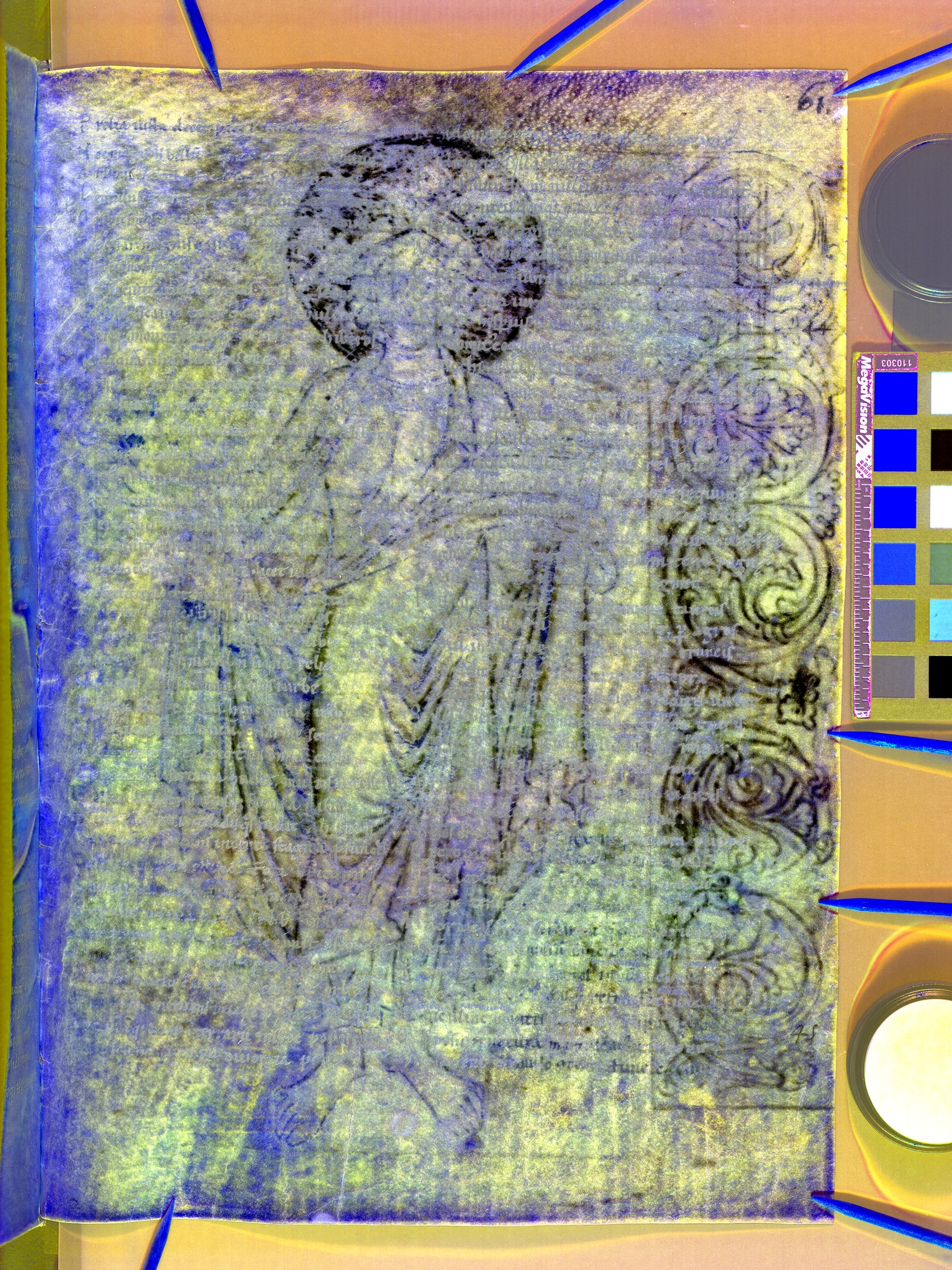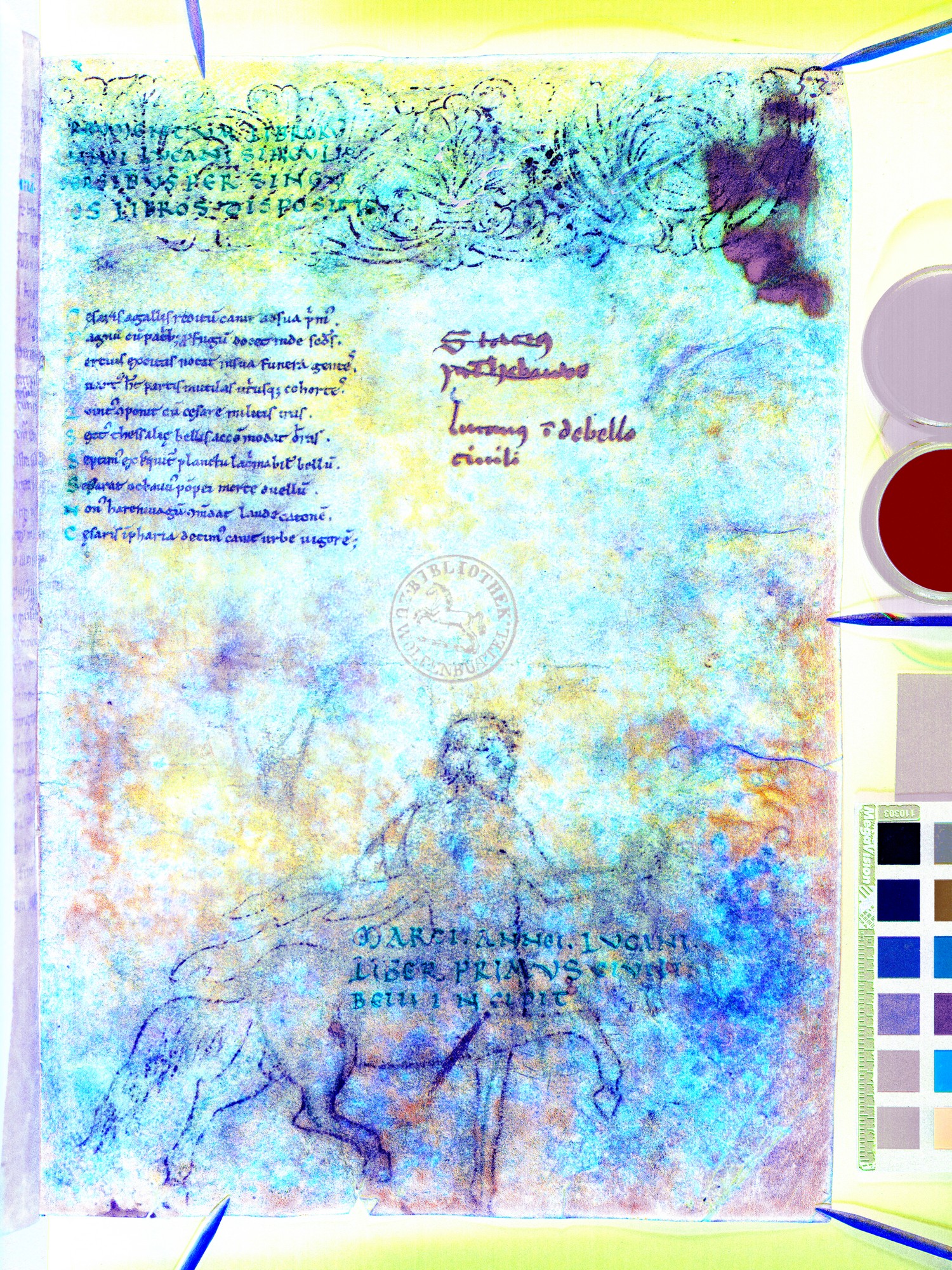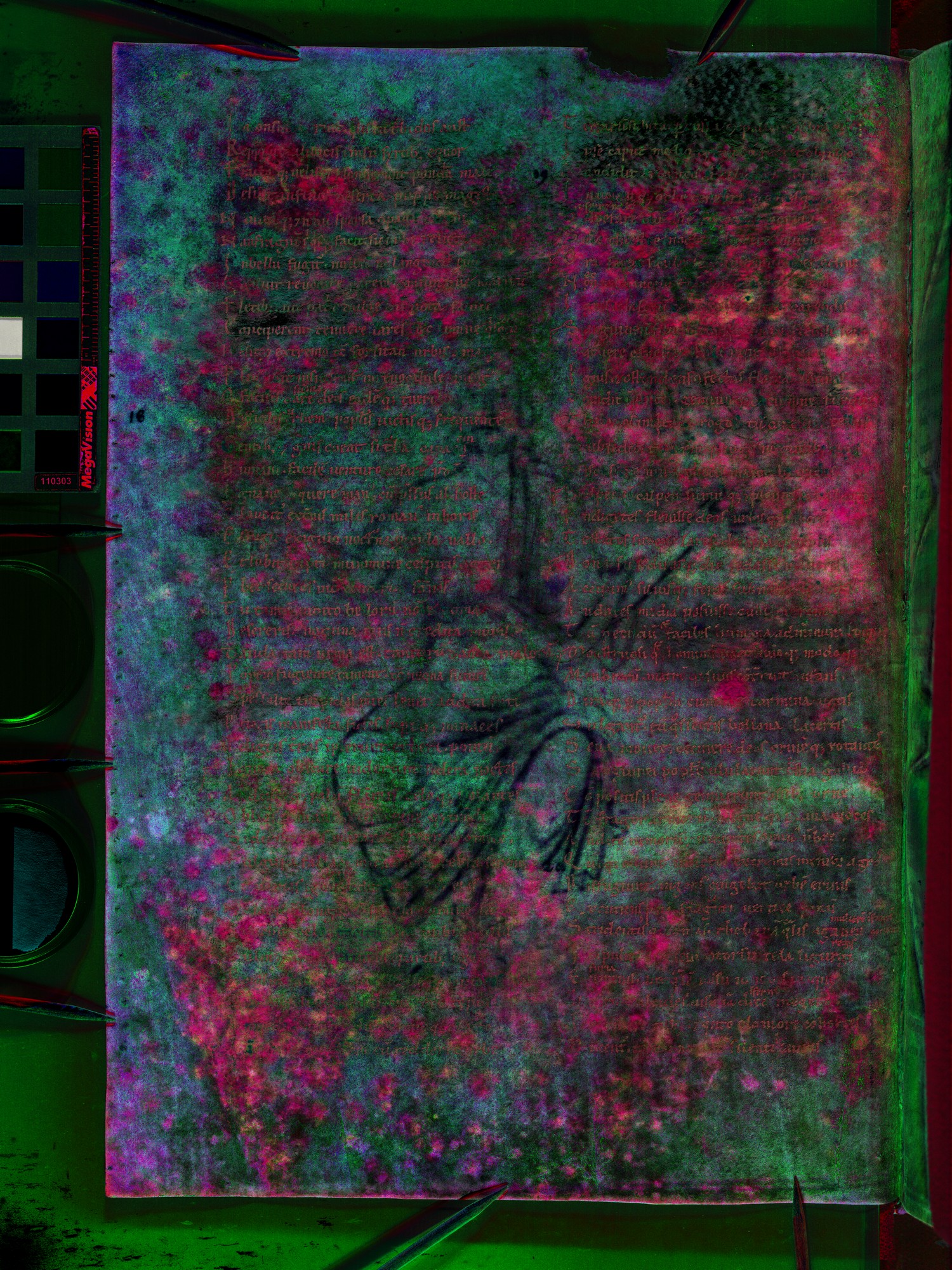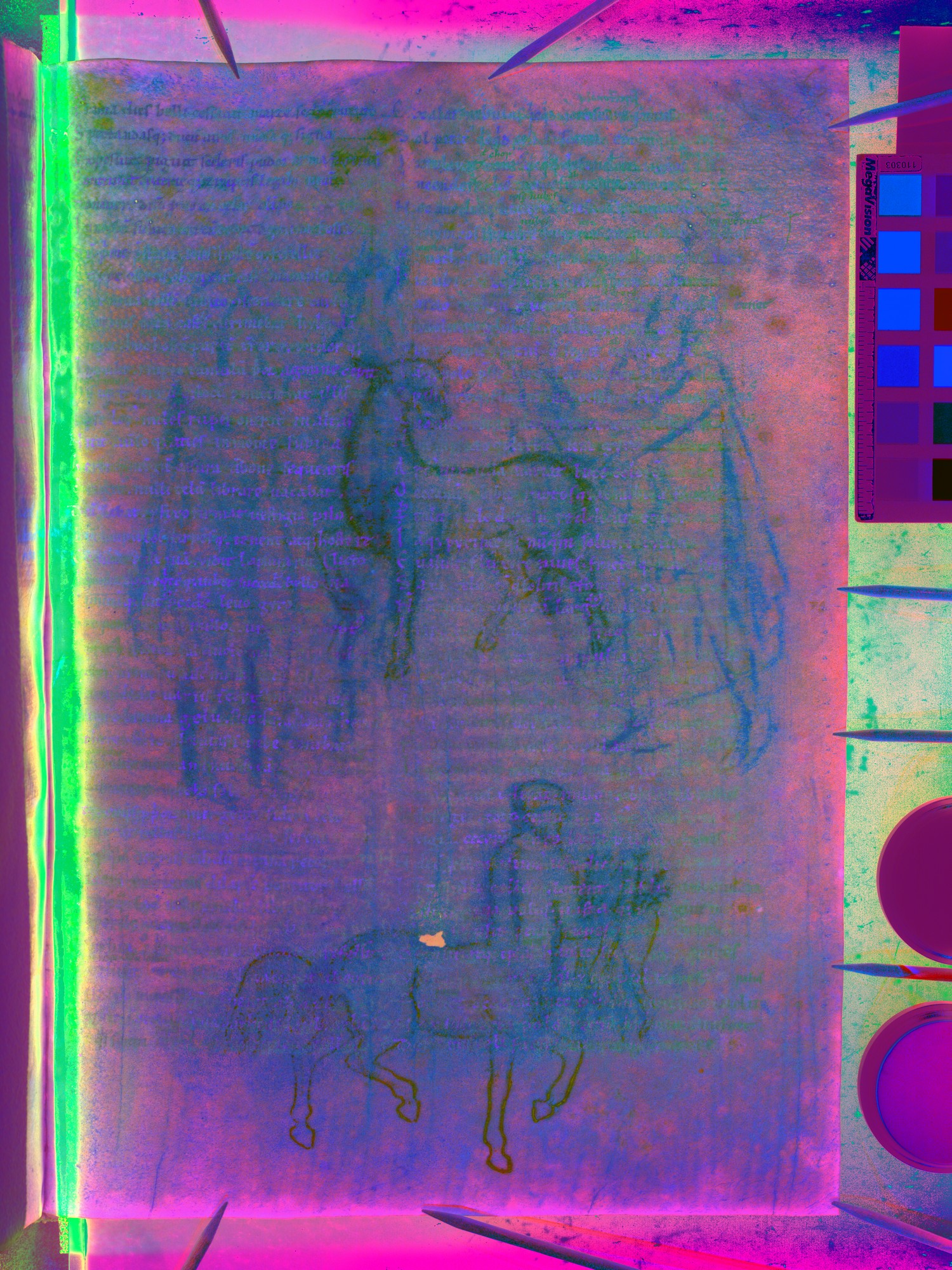No 69
Figures Under the Script:
Drawings From the Early Middle Ages Revealed
Flipping through the second half of Codex Guelf. 125 Gud. lat. at the Herzog August Bibliothek in Wolfenbüttel, containing the epic poem Bellum civile by the Roman poet Lucanus, a regular brown script, a Carolingian minuscule typical for the beginning of the 12th century, and beautiful decorated initials in red and green together catch the eye. On many of the pages, the two-column text is complemented by interlinear glosses. They were probably written by the monks or clerics who copied the main text. On a few pages of the manuscript, when one looks closely, faint traces of drawings peer out from behind the script, barely visible to the eye. A range of advanced techniques including photography with sided-light and UV-light, microscopic examination, and multispectral imaging have revealed that the folios had an entirely different life before the text of Lucanus was copied onto them.
Some words must be said first about the history of the manuscript in the Late Middle Ages and beyond. In the 15th century, the manuscript of Lucanus (fol. 53r-102v of our codex) was bound together with another manuscript from the 12th century (fol. 1r-52v). The latter manuscript contained two works by Sallustius, a Roman author who lived in the 1st century BCE, De coniuratione Catilinae and Bellum Iugurthinum. The new composite manuscript thus concerned Roman history, but the two parts nevertheless bear evident signs of their different origins: they were written in one and two columns, respectively; they were copied by different scribes; and they had different styles of decorated initials and sizes. Both original manuscripts, Sallustius and Lucanus, go back to the 12th century and were used from the beginning in a teaching and learning context, as the many marginal and interlinear glosses in them reveal. An additional note written at the end of the first part of the volume (fol. 52v) which contains a typical invective against the schoolmaster (magister) confirms this use. In the 15th century, the two manuscripts were put together and a new binding was given to the volume. The stamps on the leather which covers the wooden plates point to the Benedictine monastery of St. Ulrich and Afra in Augsburg, where the same patterns were used on other book covers. Traces of a shelfmark further corroborates that the codex was part of the library of this monastery at that moment; the paper used for the fly-leafs can be dated through the watermarks to around 1482. In the 17th century, the codex came into the possession of the German physician Bernhard Rottendorff of Münster, and later on it belonged to the philologist Marquard Gude (d. 1689).

If we now come back to the Lucanus part of the manuscript (fol. 53-68), two quires of it, as mentioned above, are palimpsests: 16 folios had been scratched before the parchment was reused for writing the Bellum civile. What emerges under the surface are drawings older than c. 1100 (fig. 1) which had not yet been detected until recent investigations. Other examples of medieval drawings in so-called model books are already known, but the number of these books from the Early Middle Ages (the 9th -11th centuries) is very limited, so this increases the value of the discovery. The object raises at the same time many questions: Where was the Lucanus manuscript written and did the parchment, which had been reused, come from another place? What can we see under the surface of the written text and how can multispectral imaging help in this investigation? Can we understand and reconstruct the intended use of the drawings which were first outlined on the parchment?
Photographs taken with ultraviolet light and raking light as well as examination under the microscope have already revealed many figures like saints, animals, constellations and decorative motifs such as acanthus scrolls, initials and architectural structures under the text of Lucanus. Multispectral analysis, however, has enabled the visualization of the lost content to a degree unattained by other techniques. As part of the process, an object is illuminated with light of different wavelengths, and spectral information is collected and statistically processed to finally reveal the lost content without damage to the object. A team from the Centre for the Study of Manuscript Cultures in Hamburg (CSMC) performed the imaging over five working days in the vault of the Herzog August Bibliothek in November-December 2016, a natural dark room with no vibrations ideal for the imaging process. A few examples of discoveries through multispectral analysis from an ongoing investigation are presented below.

On what was formerly the first folio of the manuscript of Lucanus, the impressive drawing of a centaur (a half horse, half man creature) can be discerned under the book’s title on the lower section of the page (fig. 2). In Greek astronomy, beginning with the illustration of the celestial sphere in the manuscripts of Aratus of Soli (ca. 310-240 BCE), the mythological figure of the centaur was used to describe one of the fifteen constellations south of the Zodiac. In the Early Middle Ages, various Latin translations and adaptations of the text of Aratus circulated, including those by Germanicus, probably the Roman emperor of the 1st century with this name, and those by Avienus, a Roman poet of the 4th century. In illuminated manuscripts containing these texts, one can find both images of the distinct constellations which indicate the position of the stars in the outlines of the figures, and planispheres depicting many constellations at once. Among the different texts on the constellations which were copied with corresponding images, some were attributed to Beda Venerabilis of Northumbria (d. 735), a monk and writer of many exegetical and historical works. With respect to the centaur, some texts speak of an animal (bestia) which he holds in his (right) hand (cf. the manuscript in Vienna, fol. 120r-v), while other versions add that he holds in his left hand a shield and a hare (cf. the manuscript in Paris, fol. 170r-v). Avienus speaks of a wild prey (agrestis praeda) which the centaur offers with his right hand to the altar of the Gods. In illuminated medieval manuscripts transmitting these texts, one thus finds a variety of pictorial representations of the centaur, with staff or without, holding one or two animals (in some cases with one resembling a hare), or with the skin of one animal and the body of another in his hands (cf. the manuscript in Munich, fol. 113v, 120v, and the manuscript in Boulogne-sur-Mer, fol. 29r, which is a copy of the manuscript in Leiden).
Thanks to the multispectral photographs, it is now possible to identify with precision that in our manuscript the centaur holds in his right hand the body of the bestia (the head and forelegs can be discerned), while the skin of another animal is wrapped around his left forearm and trails in the air behind him. Furthermore, on the left corner behind the centaur I believe that the skinned body of the prey (praeda) has been represented hanging on a scaffolding with its legs up, although only the upper part is discernible (fig. 2). In any case, the multispectral photographs have made better visible not only the face of the centaur and his body, but also the drama of the scene and the power of the figure.

Another image, whose interpretation can now be improved, is related to the visual depiction of the constellations as well (fig. 3). The image of a person sitting on a throne had been partially detected through ultraviolet photography, but has not been correctly understood until now. Multispectral imaging has enabled us to see clearly her outstretched arms (fig. 3), which point to the representation of the constellation of Cassiopeia. A further decisive detail is the elaborate, high headgear of the female figure, where a star appears on top (cf. parallels in the manuscript in Leiden, fol. 28v, and the manuscript in Paris, fol. 163r).
These images show that at least one group of the drawings on the reused folios represented models or exercises of very high quality for the illuminated sections of a book which could accompany the text of Aratus latinus or other texts on the celestial cosmos during the Early Middle Ages. That they were exercises or possibly models is corroborated by the fact that no trace of text was found close to these images. Besides images related to the constellations, the folios contain images corresponding to the traditional Christian repertoire, such as the blessing Christ with the book of Gospels in his left hand (fig. 1), which is similar in style to North French examples of the 11th century. There is also a wide range of other motifs including decorative leaf tendrils and architectural elements. Moreover, various layers of re-working on the parchment can be discerned, such as in as the addition of a draft of the Lamb of God above an earlier scene on fol. 67r (fig. 4; a second centaur is also there). Some figures were drawn only with a metal hard point. These observations together point to intense and repeated use of the original folios (which could have formed a booklet at some point) among the artists of a scriptorium. From a codicological point of view, it is not possible to determine with certainty whether the folios were bound together or simply piled together in a certain place, where the manuscripts were copied and illuminated.

In conclusion, the discovered figures under the script allow us to begin investigating the interactions between (re-)writing, drafting and illuminating practices within an advanced scriptorium in which books of very good quality were being produced. The first step is to completely and correctly describe the drawings. In this case many advanced techniques, above all multispectral imaging, have helped to make visible what is not discernible by the naked eye or through other techniques. Comparison with other clearly preserved images from the Middle Ages is now possible, and this can lead to precise identification of the subjects and of possibly coherent cycles of images (e.g. for the Aratus manuscripts) which were intended to be produced. Also, the dating of the drawings can be established more precisely when the images are made visible in full detail.
References
- AVIENUS (2003): Les Phénomènes d’Aratos. Edited and translated by Jean Soubiran. Paris: Les belles lettres.
- BLUME Dieter / HAFFNER, Mechthild / METZGER, Wolfgang (eds.) (2012): Sternbilder des Mittelalters. Der gemalte Himmel zwischen Wissenschaft und Phantasie, vol. I, 1-2: 800 – 1200. Berlin: Akademie Verlag.
- CARMASSI, Patrizia (2016): “From the codex to the libraries: Gudianus latinus palimpsest: Herzog August Bibliothek, Cod. Guelf. 125 Gud. lat.”. In: Patrizia Carmassi(ed.): Retter der Antike. Marquard Gude (1635-1689) auf der Suche nach den Klassikern. Wiesbaden: Harrassowitz, 263-307.
- DELL'ERA, Antonio (1979): “Una rielaborazione dell'Arato latino”. In: Studi medievali ser. 3, 20, 269-301.
- DEKKER, Elly (2013): Illustrating the Phaenomena. Celestial Carthography in Antiquity and the Middle Ages. Oxford: Oxford University Press.
- EASTON, Roger L. / David KELBE (2014): “Statistical Processing of Spectral Imagery to Recover Writings from Erased or Damaged Manuscripts”. In: manuscript cultures, 7, 35-46.
- GEE, Emma (2013): Aratus and the Astronomical Tradition. Oxford: Oxford University Press.
- GEYMONAT, Ludovico (2016): “Carolingian drawings in the Wolfenbüttel Centaur Palimpsest”. In: Patrizia Carmassi (ed.), Retter der Antike. Marquard Gude (1635-1689) auf der Suche nach den Klassikern. Wiesbaden: Harrassowitz, 309-347.
- KATZENSTEIN, Ranee (1988): The Leiden Aratea. Ancient Constellations in a Medieval Manuscript. Malibu, California: The Getty Museum. http://www.getty.edu/publications/virtuallibrary/0892361425.html (accessed on 26/11/2018).
- SCHELLER, Robert W. (1995): Exemplum. Model-book Drawings and the Practice of Artistic Transmission in the Middle Ages (ca. 900 - ca. 1470). Amsterdam: Amsterdam University Press.
Description
Wolfenbüttel, Herzog August Bibliothek, Cod. Guelf. 125 Gud. lat.
Material: Vellum, 102 folios
Dimensions: 260 x 185 mm
Date: the script on the surface, fol. 53r-102v: Gembloux (?), first half of the 12th century; drawings underneath the script, fol. 53r-68v: North France (?), end of the 11th century.
Content: Sallustius, De coniuratione Catilinae and Bellum Iugurthinum and other minor texts, fols. 1-52; Lucanus, Bellum civile, fols. 53-102; drawings under the text, fols. 53-68.
Additionally mentioned manuscripts
Manuscript in Boulogne-sur-Mer, Bibliothèque municipale, Ms 188.
Manuscript in Leiden, Universiteitsbibliotheek, Ms. Voss. lat. Q 79.
Manuscript in Munich, Bayerische Staatsbibliothek, Clm 210.
Manuscript in Paris, Bibliothèque nationale de France, MSS latin 5543.
Manuscript in Vienna, Österreichische Nationalbibliothek, Cod. 387.
Reference note
Patrizia Carmassi, “Figures Under the Script: Drawings From the Early Middle Ages Revealed”
In: Wiebke Beyer, Zhenzhen Lu (Eds.): Manuscript of the Month 2017.09, SFB 950: Hamburg,
http://www.csmc.uni-hamburg.de/publications/mom/69-en.html
Text by Patrizia Carmassi
© for all pictures: CSMC
Photos and image processing: Ivan Shevchuk, CSMC
